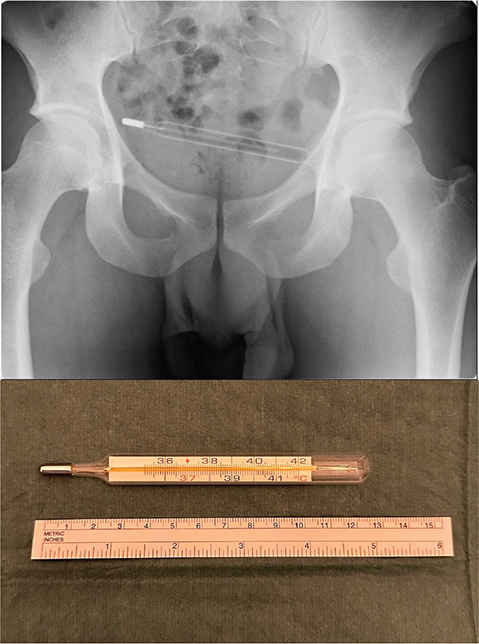CASE REPORT
Taking the temperature: a case of urethral polyembolokoilamania
Kristian Lyngholm Stranda,b and Jan Maciej Krzaka,c
aSurgical Department, Dronning Ingrids Hospital, Nuuk, Greenland; bDepartment of Urology, Rigshospitalet, University of Copenhagen, Copenhagen, Denmark; cDepartment of General Surgery, Hospital Sønderjylland, Aabenraa, Denmark
Citation: Scandinavian Journal of Urology 2023, VOL. 58, 28–29. https://doi.org/10.2340/sju.v58.7125.
Copyright: © 2023 The Author(s). Published by MJS Publishing on behalf of Acta Chirurgica Scandinavica. This is an Open Access article distributed under the terms of the Creative Commons Attribution-NonCommercial 4.0 International License (https://creativecommons.org/licenses/by-nc/4.0/), allowing third parties to copy and redistribute the material in any medium or format and to remix, transform, and build upon the material for non-commercial purposes, provided proper attribution to the original work.
Received: 11 January 2023; Accepted: 4 May 2023; Published: 10 July 2023
*Equally contributed.
CONTACT Kristian Lyngholm Strand kristian.strand@rsyd.dk Fruerstuevej 21, 5700 Svendborg, Denmark.
Introduction
Polyembolokoilamania is the practice of self-insertion of a foreign body into body orifices including the urethra, and urethral polyembolokoilamania is commonly known as urethral sounding. The reasons for urethral sounding vary, ranging from autoerotic stimulation and intoxication to underlying neurological or psychiatric disorders [1–3]. Urethral sounding has been reported to be practiced by both men and women [1–5] and was described already in 1868 [4] with an increasing incidence of reports in recent years [2]. A wide array of objects used for urethral sounding has been reported, ranging from household items like toothbrushes, pencils and batteries, to organic material like wood, plants and animal parts [2].
Urethral sounding is associated with increased risk of urinary tract infection, urinary retention, abscess, mucosal tears, urethral diverticulum, urethral fistula, urethral strictures and with the entrapment of foreign bodies in the urethra or bladder, which may require surgical removal [1–5].
Diagnosing a foreign body in the lower urinary tract caused by urethral sounding can be difficult, as patients may not report the exact nature of the problem out of embarrassment or due to an underlying neurological or psychiatric disorder [2].
Case report
We present the case of a 20-year-old man with no significant prior illness, who contacted the emergency department of a local hospital in Greenland with a mercury-in-glass thermometer stuck in his bladder.
The thermometer had been self-inserted the previous day during the act of urethral sounding for autoerotic stimulation. At the time of contact, the patient reported unhindered urination but with pain upon complete emptying of the bladder.
The diagnosis was confirmed with a pelvic radiograph, which showed the thermometer in the bladder [Fig. 1]. A digital rectal examination was performed to rule out any foreign object in the rectum.

Figure 1. The thermometer shown inside the bladder on a pelvic radiograph and after removal.
Upon arrival to our department the day after the diagnosis, the patient reported feeling well and being without abdominal pain or gross hematuria. As no urologist was present at the time, the surgical approach was discussed with a urologist consultant in Denmark. Endoscopic retrieval of the thermometer was ruled out due to the risk of breakage. The thermometer was removed via an extraperitoneal suprapubic cystotomy through a Pfannenstiel incision. The patient was left with an indwelling catheter to be removed at the local hospital. The postoperative course was uneventful and the patient was discharged day 1 after surgery. At follow-up by phone 4 weeks after the operation, the patient reported no lower urinary tract symptoms.
Discussion
Diagnosing a foreign body in the lower urinary tract can be complicated. Patients may present with lower urinary tract symptoms, hematuria or unspecific pain, but without mentioning urethral sounding [2].
Foreign bodies in the lower urinary tract can be removed by different surgical techniques, so management depends on the individual case. Endoscopic removal using, for example, Endoloop, forceps or stone basket is minimally invasive and should be preferred when appropriate, but may prove difficult or unsafe depending on the type of inserted object. In such cases, open surgery should be considered [1–3, 5].
In our case, accidentally breaking the thermometer inside the patient could have resulted in shards of glass in the bladder and/or urethra with following mucosal damage or perforation, and possibly mercury poisoning.
Our case shows that it is important to consider complications to urethral sounding as a differential diagnosis when encountering unexplained symptoms from the lower urinary tract.
Urethral sounding poses short- and long-term risks, and patients who have performed urethral sounding should be informed about associated risks, and strongly advised only to use items specifically designed for the purpose, that is, sex toys.
References
- [1] Crawford SB, Lowry D, Watts SH. Evaluation and management of urethral foreign bodies and description of a novel ultrasound-guided catheter-based extraction technique. J Am Coll Emerg Physicians Open. 2021;2:e12398. https://doi.org/10.1002/emp2.12398
- [2] John J, Kesner K. Urethral polyembolokoilamania: not a bread-and-butter issue. Ther Adv Urol. 2021;12:17562872211022866. https://doi.org/10.1177/17562872211022866
- [3] Loufopoulos I, Kapriniotis K, Kennedy C, et al. Urethral self-insertion of a USB cable as sexual experimentation: a case report. Urol Case Rep. 2021;39:101850. https://doi.org/10.1016/j.eucr.2021.101850
- [4] Watson PH. On the extraction of foreign bodies from the female bladder. Br Med J. 1868;2:382–83. https://doi.org/10.1136/bmj.2.406.382
- [5] Al-Zubaidi M, McCombie S, Bangash H, et al. A novel technique to remove a urinary bladder foreign body endoscopically using an Endoloop. Urol Case Rep. 2021;40:101899. https://doi.org/10.1016/j.eucr.2021.101899